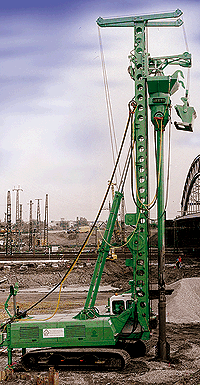Dry Stone Columns
Dry Bottom Feed Stone Columns were invented in Germany in the early 1970’s. They are particularly useful if washout of soil to the surface is to be prevented or where handling of process water for the Wet Top Feed method is problematic.
Dry Bottom Feed Stone Columns have been successfully used on large infrastructure projects like earth dams, highway embankments, airport runways, port facilities and under large industrial structures such as oil tanks and silos. They are a common choice for foundations in liquefiable soils in earthquake prone areas.
The V-Rex
The V-Rex is a state-of-the-art custom built machine for Dry Bottom Feed Stone Columns rigs.
Some of the advanced features include:
Built in data acquisition
Easy mobilization/demobilization
Modular leader extensions
Process control computer, combined with electronic winches, drives rig during column installation on “autopilot”.

The Vibro Stitcher ®

The need for a fast and very efficient method of forming shallow to medium depth dry bottom feed stone columns led to the development of the stitcher.
Advantages of the Vibro Stitcher:
• Simple operation. No high tech gravel transport system involved.
• Vibroprobe can be pushed down with force to preload the column while producing it and to speed up the process.
• Verticality of the Vibroprobe can be controlled and corrected by the excavator, manually or automatically.
Stone Columns and Liquefaction Mitigation
Loose sandy soils below the water table liquefy during an earthquake. To prevent this, stone columns can be installed and have a threefold effect:
• They drain the soil.
• They compact loose sand and gravel layers.
• They reinforce layers that cannot be compacted and facilitate drainage (mainly very silty sands to sandy silts)
